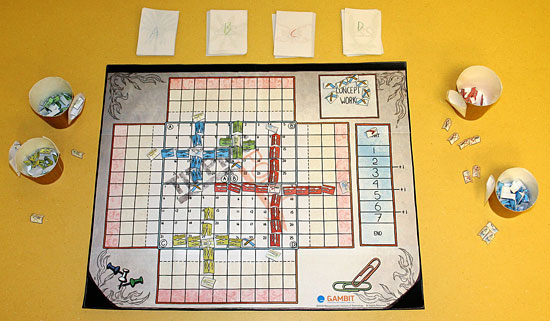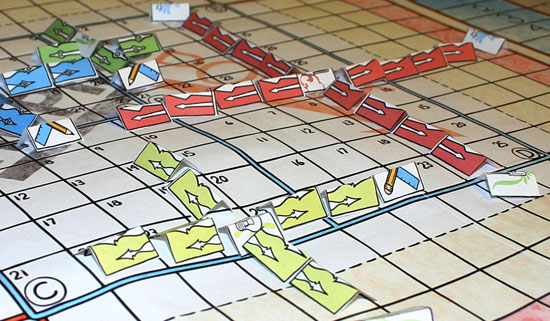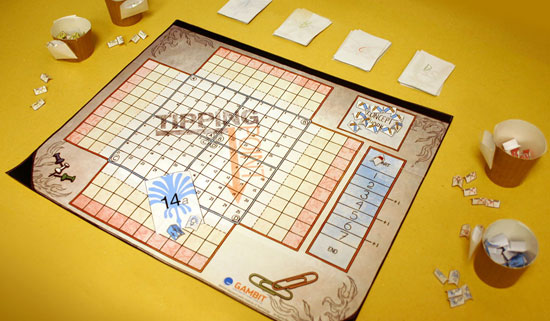
Recently in Research Category
I've just returned from a wonderful whirlwind trip to Los Angeles which found me first attending Indiecade in Culver City (where I got to hang out with my friends Doris C. Rusch, Josh Diaz, Brenda Brathwaite, Celia Pearce and Tracy Fullerton - and where, thanks to Brenda, I got to meet John Romero, which was very cool), paying a really terrific and insightful visit to USC's game lab (thanks, Kurosh!), touring LA first with my best man Talon and his wife Sara and then with Henry and his wife Cynthia, and then finally giving a relatively brand-new talk on designing migratory characters for transmedia stories in Henry's transmedia class at USC.
I'm now back in Boston, backlogged and trying to fend off a cold (stupid planes). There's been a number of interesting transmedia-related articles and things popping up across the web while I've been traveling. Here are the ones that have struck me as the most interesting:
- Massiverse Launches Dragons vs. Robots. Like pirates versus ninjas, dragons versus robots is one of those concepts that hooks you as soon as you hear it. Whether or not Massiverse can pull it off is anyone's bet - but they seem to be listening closely to what Henry and the rest of us academic types are advocating, so this should be interesting. My favorite line in Dean Takahashi's writeup: "[Transmedia storytelling is] sort of like going fishing with a lot of different kinds of lures in the water." I hadn't thought of that particular metaphor before, but it's absolutely perfect. More about Dragons vs. Robots can be found here, here.
- Muse and Transmedia. John Griffiths ponders about how the promotional efforts for the rock band Muse might be read as a transmedia story. I'm not quite sold; this still feels more like a traditional advertising campaign and less like a piece of deliberately plotted transmedia planning. Still, Griffiths is right to consider about the potential for such things. Nine Inch Nails' Year Zero ARG could definitely be read as a transmedia planning campaign, and I'm sure there's a case study to be found in the promotional campaigns for U2 and/or R.E.M. in there somewhere.
- J.C. Hutchins' Sword of Blood transmedia extension is a quilt. Well, a PDF of a quilt, anyway – but it's still extremely cool. A premium subscription model might have delivered an actual quilt, which would have been a terrific example of diegetic artifact as transmedia extension. (I'm still convinced that clothing and textiles are an as-of-yet largely untapped realm of possibilities.)
- The Upside-Down World of New Media. This brief post from Scott Crawford ponders how transmedia storytelling is an inversion of the brand platform planning model traditionally found in advertising. I'd like to see Crawford return to the subject and expand on what he thinks transmedia storytelling could gain from studying traditional brand platform planning – there's at least one long, solid essay in there.
- A Transmedia Exercise. This assignment from Malcolm Ryan's Game Design workshop at the University of New South Wales in Australia seems to be more about solid worldbuilding than about leveraging the unique advantages of transmedia storytelling, but it's a great way to get students thinking about it.
- What is Branded Content? Tubefilter assembles an interesting panel of four experts who seek to tease out exactly what 'branded content' is - and, at the end of the day, sums up their insights thus: "In a world where even the lines of real life and fiction are starting to blur though 3-D and augmented reality technologies, brands and content must work together to create holistic experiences that extend beyond the :30-second spot - and even beyond the delivery platform itself - to form an emotional bond with viewers. Brands and content creators must also realize that old rules no longer apply. They need each other. Content creators need brand sponsors to bring their vision to life and fund a quality production, and brands need content creators to substantively connect with consumers. But none of those things can be achieved without trust. And nothing influences consumer behavior more than an experience that moves them - and a brand they can believe in." Well said.
- Transmedia Storytelling, ARGs and Civic Engagement. Bonnie Shaw at Echo Ditto provides a solid snapshot of where and how transmedia storytelling, ARGs and civic engagement are cross-pollinating one another - and how it could be improved.
- Seven Projects Selected for Power to the Pixel Pitch. I've gotta admit, out of all of these Brand New-U sounds the most intriguing to me.
- Hush on Click 2009. Shoot, it sounds like Click 2009 was the place to be last week - I would've loved to hear what Jason Zada had to say about transmedia, and I would have really enjoyed seeing Michael as the master of ceremonies!
- Faris Yacob on transmedia planning, the future of brand communication... You know, the usual. And, as usual, Faris is sharper than razors.
- Anthony Zuiker at the HuffPo. "We can no longer make the audience come to us. We must go to the audience and re-invent ourselves based on behaviors that will never return to the old regime. It will be the convergence of multi-media or trans-media, consuming content 'specific to the device,' that will win out going forward. Our attention economy is shrinking while our attentive economy is changing. And while no human being can verbalize with certainty when our behavior shifted, we must realize there has been a shift in the first place if we hope to keep up with it. It's no longer the wild wild West but the global network of the technological revolution that will shape our consumptive future." I'm still not crazy about the term 'digi-novel', but Zuiker definitely gets it.
- BBC does transmedia with new horror story The Well. Victoria Jaye, the acting head of fiction and entertainment multiplatform commissioning, will be speaking at FoE4 here at MIT in November. I can't wait to grill her on this one. And I bloody love this quote from writer Melvin Burgess: "A ghost story is perfect for [transmedia], because at the heart of every ghost story is a mystery waiting to be solved - a back story, about how the horror arose and others in the past who have brought it back to life."
- Levi's launches an ARG. This sounds suspiciously like the work of a certain cyborg anthropologist I know who's currently doing some work there at W+K. Amber, is this your doing?
- Joe Digital's take on "Transmedia 360". I was with them right up until they name-dropped Lord of the Rings; I'm trying to figure out if they're referring to the additive comprehension Neil Young was trying to slip into the LOTR game from EA, but the article is pretty vague.
I'm not even going to go into the big ones here – like Don "The Design of Everyday Things" Norman on transmedia as co-creation, or Kathy Hansen's proposal for how to use transmedia storytelling in job applications. Those are both posts on their own, which I'll sketch out as soon as I have some time.

Geoffrey Long: First of all, welcome! Where are you coming from?The complete article can be read online on the CMS site. Alternatively, the full Fall 2009 issue of In Medias Res can be downloaded as a 1.4 MB PDF for on-screen reading or as a 42 MB PDF for high-quality printing. Check it out!
Mia Consalvo: I'm coming from Davis Square, but I most recently come from Ohio University's School of Media Arts and Studies. I'm an associate professor there, and I teach classes in new media, media criticism and analysis, and videogame studies. I wrote a book with MIT Press in 2007 about cheating in videogames, and right now I have two big projects going. One is on the role of Japan in the formation of the game industry and its status now, and the other relates to casual games and casual game players and casual game player culture and those kinds of things.
GL: What stage are you in with these projects?
MC: I've written a few smaller pieces that have been articles or chapters for other things that are eventually going to be collected into a book. One of the pieces, which I wrote when I was here at MIT last summer as a visiting scholar, was on the business aspect of Japanese videogame industries and how they're trying to push more for globalization.
Interestingly, even though Nintendo kind of resurrected the videogame industry in the 1980s after it went bust, and most Western kids grew up playing Nintendo, once Western companies got back up and going there was a decline in sales of Japanese games, so that now Japanese games aren't quite as dominant in the West. In Japan, it's still almost completely Japanese games on the top sellers list, but in North America and Europe it's much more split, and you see Japanese companies trying to figure out how to get that global dominance back. They have plans for different kinds of localization, transnational products, those kinds of things.
GL: When you're talking about the East and the West, you're not talking about just Japan and the United States. What is the game sale breakdown like in the rest of the world?
MC: There are three major game markets that companies look at: North America, Europe (and mostly that's Western Europe) and Japan. Korea has its own special thing with online games, but otherwise they're kind of too small. North American bestseller lists are clearly mixed as to what games are made where, and Europe is the same. There are few local European products that wouldn't sell somewhere else, like football games, and the Germans prefer PC games over console games, particularly strategy games.
In Japan, there's been this dominance of Japanese companies. When I was there in 2005 for a few months, it took me a while to realize, looking at the bestseller lists, "Wait a minute, there are no Western games here!" There were a few, like Halo and The Sims, but it was almost completely dominated by Japanese game developers. Now, because of the downturn in the economy and the declining birth rate in Japan, they've seen some declines in their sales, and Japanese companies are more motivated to look globally for other markets.
- Community Voting Prize in Jan 2009 for the highest voted tutorial in that month
- First prize in the Best Physics Knowledge Base Entry category (just announced at the 2009 Game Developers Conference in San Francisco)





